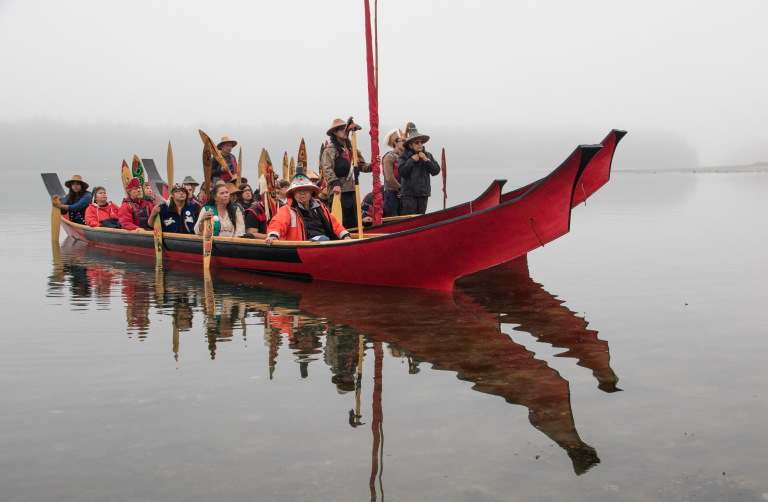How Indigenous Cuisine Connects Us To Local Cultures
We can all learn from ancient, seasonal food practices and traditions when we travel.
 Photo © Walkabout Cultural Adventures and Tourism and Events Queensland
Photo © Walkabout Cultural Adventures and Tourism and Events Queensland
After escaping the tourist crowds of Tulum, I found myself sleeping in a hammock beneath a thatched roof hut in a small, dusty Mayan village on Mexico’s Yucatan Peninsula. Every morning and every evening, I had the pleasure of sitting beneath the shade of palm trees while indulging in a colorful spread of fresh foods prepared by the women in the village. Green avocado smashed with lime and salt. Magenta-hued water pressed from fresh hibiscus leaves (or, in Spanish, jamaica). Corn tortillas, black beans spiced with chilies, and steaming tamales wrapped in corn husks cooked underground. Many of these dishes are familiar suspects commonly associated with contemporary Mexican cuisine. In reality, all of these dishes have much older roots. They have origins with the indigenous Mayan peoples inhabiting the Yucatan peninsula of modern-day Mexico, whose cuisine dates back as far as 1500 BC.
Many of our favorite foods from around the world have ancient indigenous heritages. From familiar ingredients such as quinoa, avocado, cacao, wild salmon, squash, and maple syrup, to lesser recognized ancient ingredients that were once commonly foraged such as yaupon (the only indigenous caffeinated plant in North America), chokeberries, and timpsula (a wild prairie turnip) in the Americas, to lemon myrtle and finger limes in Australia, indigenous cuisine is deeply tied to the local land.
Over the past several centuries, colonialism and globalization spurred an unprecedented movement of people, goods, and ideas. Consequently, the trajectory of the world and food as it once existed was permanently altered. Indigenous foods and techniques were blended with new ingredients and over time new dishes and fusion foods commonly recognized in contemporary cuisine emerged. Consequently, the purity of indigenous cuisine was lost, along with its culture association.
As original stewards of the land who lived in rhythm with the changing of seasons, a celebration of seasonal, local ingredients with conservation-focused techniques such as foraging, pickling, and curing was, and still are, fundamental to indigenous diets. The native Sami people from the Lapland region of Sweden, Norway, and Finland, for example, have at least eight seasons of food. Reindeer is central to Sami cuisine and every part of the animal is used, in stews, cured into sausages, reserved after slaughter, so it lasts through the winter. Cloudberries, mushrooms, and lingonberries are some of the goods the Sami forage in the forest, used fresh, in jams, and in herbal concoctions.
In an age where hyper-local, hyper-seasonal cuisine is taking the center stage in dining experiences, we should look to indigenous traditions to understand this increasingly important ethos to how we eat. It’s nothing revolutionary but rather a return to ancient wisdom and a reverence for the land.
Indigenous food experiences
From North, Central, and South America, to Australia and New Zealand, indigenous communities around the world are working to preserve and celebrate the food of their ancestors and the food that is still prominent in their cultures today. For foodies, history buffs, and conscious consumers alike, there are an array of cafes, restaurants, and immersive experiences focused on fostering the cuisine of indigenous communities. On your next travels, whether they be far afield or simply at a dining establishment in your hometown, seek out culinary experiences that celebrate indigenous food. We’ve rounded up a few of our favorites for some inspiration. Keep in mind, that while some are curated, others can be experienced by tapping into the local food scene in countries such as Mexico and Guatemala.
Café Ohlone in Berkeley, CA, USA: described as a “love song to Ohlone culture,” Café Ohlone transports guests to a reimagined time as they enter a redwood-framed shadow box where native plants dance in the sun and wind. This café at the University of California Berkeley’s Hearst Museum of Anthropology is dedicated to the preservation and celebration of the history and culture of the Ohlone tribe. A garden thrives with aromatic native plants that are used in various teas and dishes on the menu. The dining experience at Café Ohlone is intentional and educational, designed to immerse visitors in every element of Ohlone culture. Traditional, seasonal foods such as black oak acorn soup, chanterelle mushrooms, Dungeness crab, and teas made from yerba Buena, elderberry, and hummingbird sage make for a colorful and intriguing menu. Café Ohlone is as much a celebration of Ohlone culture for guests to experience, as it is a gathering space for the Ohlone people, where language classes, cultural sessions, and food drop-offs are held.
Songhees Nation Food Truck in Victoria, British Columbia, Canada: the Songhees Nation hold a prominent place along the waters of southern Vancouver Island, British Columbia. To honor this heritage and promote cultural awareness, the Songhees Nation Food Truck was started in 2016 as a partnership between the Songhees Nation and Clipper Vacations (the ferry traveling between Victoria and Seattle). Currently, the food truck is fully Songhees-owned and run. Aaron, or Cheethlum in Coastal Salsih, says that the goal behind the truck is to “use modern twists on traditional foods. The features we do are fun, and we like to use seafood when possible.” The menu features fresh, local ingredients like wild salmon, bison, and bannock (a flatbread), that echo the culture of the Songhees. These Songhees-inspired culinary creations can be enjoyed in a relaxed seating area designed to look like a traditional longhouse.

Walkabout Cultural Adventures in Queensland, Australia: Juan pointed to the tree trunk crawling with green ants. “Do you see these green ants? They have a distinct lime flavor.” He held the head of a squirming ant as I bit off the end and waited for the burst of citrus. In Kuku Yalanji country around the Daintree Rainforest, green ants are commonly used for seasoning and medicine. Seven Seasons has even distilled a Green Ant Gin, which has a distinctively citrus pop. Beyond emerald-colored insects, the Daintree Rainforest in Tropical Northern Queensland is abundant with fresh ingredients found within the thick tangles of the forest, including berries and fruits like Damson, native gingers, and pencil cedar fruit. And among the marshy mangroves bordering the coast, one can collect shellfish, snails, cockles, crabs, and fish. With Walkabout Cultural Tours, an aboriginal-run company, you can accompany guides like Juan into the rainforest and along the coast to learn about what the Kuku Yalanji people traditionally ate and what they foraged for in the bush for food and medicine. “Sharing our culture and creating an understanding with a broader audience is a pathway to preservation and reconciliation,” remarked Juan. “And like most cultures, the sharing of food brings family and people together.”
Hiakai in Wellington, New Zealand: Maori culinary experiences aren’t the easiest to come by in New Zealand, or Aotearoa as the modern nation is called in Maori. Traditional dishes and ingredients from the native stewards of Aotearoa include the likes of fresh mussels in puha juice (fern thistle), pikopiko (fern roots), kumara (sweet potato), and local species of fish. Hangi is a traditional method of cooking beneath the ground, using heated rocks buried in a pit oven. If you find yourself in Wellington, it’s worth making a reservation at Hiakai. First started as a pop-up series hosted by chef Monique Fiso that focused on exploring and showcasing Maori cooking techniques, Hiakai has now landed in a permanent space in Wellington. This women-led establishment has challenged and pushed the boundaries of Maori cuisine in New Zealand, paving the way for an innovative exploration of indigenous cuisine meeting modern, exploratory techniques. The menu is inspired by “the whenua (land), moana (sea), and tāngata (people) of Aotearoa”; a reflection of the Maori’s deep respect for the earth and the ocean.
Owamni by the Sioux Chef in Minneapolis, Minnesota, USA: Sean Sherman, author of The Sioux Chef’s Indigenous Kitchen, first opened Owamni as a catering company. In 2021, it transitioned into a permanent establishment serving Dakota and Ojibwe dishes. The menu is completely decolonized, meaning that it exclusively uses ingredients that were found in North America prior to European colonization. Curious what this looks like? Blue corn bread, elk with blackberries and cranberries, wild rice, and bison and black bean stew are among the dishes that guests can choose between. Colonial ingredients, such as dairy, cane sugar, and wheat flour won’t be found on the menu. At its heart, Owamni serves decolonized food of “Mni Sota Makoce: Land Where the Waters Reflect the Clouds.”
Related articles
Simple and flexible travel insurance
You can buy at home or while traveling, and claim online from anywhere in the world. With 150+ adventure activities covered and 24/7 emergency assistance.
Get a quote

No Comments